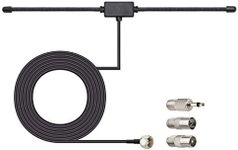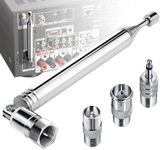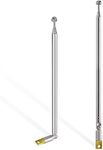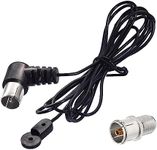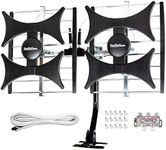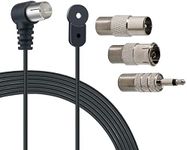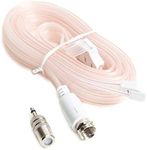Buying Guide for the Best Indoor Fm Antennas
Choosing the right indoor FM antenna can make a big difference in the quality of radio reception you get at home. Since FM signals can be affected by building materials, distance from radio stations, and interference from other electronics, it's important to consider your specific environment and listening habits. The best antenna for you will depend on where you live, how far you are from broadcast towers, and how you plan to use your radio. Understanding the key features of FM antennas will help you make a smart choice that fits your needs.Antenna TypeThe type of antenna refers to its design and how it captures FM signals. Common types include wire dipole, telescopic, and loop antennas. Wire dipole antennas are simple and can be hung on a wall or window, making them good for general use. Telescopic antennas are adjustable metal rods that can be extended or angled for better reception, often found on portable radios. Loop antennas are compact and can be placed on a table, offering good performance in areas with moderate signal strength. If you have limited space or want something discreet, a loop or compact dipole might be best. If you want to experiment with positioning for the best signal, a telescopic antenna gives you more flexibility.
Frequency RangeThe frequency range tells you what part of the FM spectrum the antenna can receive. Most FM antennas are designed to cover the standard FM band (usually 88 to 108 MHz). This is important because you want to make sure the antenna can pick up all the stations you want to listen to. If you only listen to standard FM radio, any antenna covering this range will work. If you are interested in other bands (like AM or shortwave), you may need a multi-band antenna, but for most FM listeners, a standard FM range is sufficient.
GainGain is a measure of how well the antenna can pick up weak signals. Higher gain means the antenna can receive stations that are farther away or have weaker signals. Gain is usually measured in decibels (dB). Low-gain antennas are fine if you live close to radio towers or in a city with strong signals. Medium-gain antennas are good for suburban areas, while high-gain antennas are best for rural locations or places with lots of interference. Think about how far you are from the stations you want to hear—if you have trouble getting clear reception, a higher-gain antenna may help.
Cable LengthCable length refers to how long the wire is that connects the antenna to your radio. A longer cable gives you more flexibility to place the antenna in the best spot for reception, such as near a window or away from electronic devices that cause interference. However, very long cables can sometimes reduce signal strength. For most homes, a cable length of 3 to 6 feet is enough, but if your radio is far from a good spot, look for an antenna with a longer cable. Choose a length that allows you to position the antenna for the clearest signal without being too long to manage.
Connector TypeThe connector type is the plug that attaches the antenna to your radio. Common types include 3.5mm, F-type, and bare wire. It's important to match the connector to your radio's antenna input. If your radio has a specific input, make sure the antenna you choose is compatible, or be prepared to use an adapter. Check your radio before buying to avoid compatibility issues.
Adjustability and Placement OptionsSome antennas can be adjusted or moved to improve reception, while others are fixed in shape. Adjustable antennas, like telescopic or flexible dipoles, let you experiment with different positions and angles to find the best signal. Fixed antennas are easier to set up but may not work as well in challenging environments. If you have trouble with reception or want to fine-tune your listening experience, look for an antenna that can be easily adjusted or repositioned.
